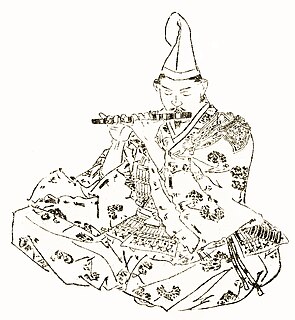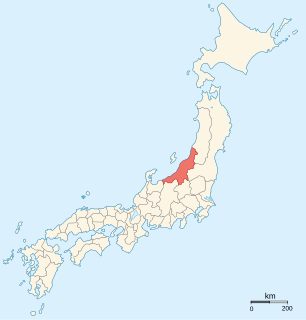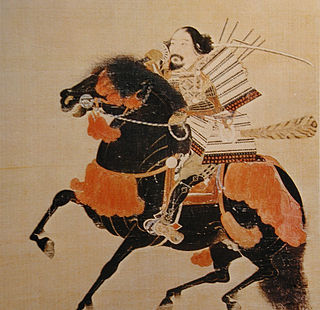
Ashikaga Yoshiakira was the 2nd shōgun of the Ashikaga shogunate who reigned from 1358 to 1367 during the Muromachi period of Japan. Yoshiakira was the son of the founder and first shōgun of the Muromachi shogunate, Ashikaga Takauji. His mother was Akahashi Tōshi, also known as Hōjō Nariko.

The Kenmu Restoration (1333–1336) is the name given to both the three-year period of Japanese history between the Kamakura period and the Muromachi period, and the political events that took place in it. The restoration was an effort made by Emperor Go-Daigo to bring the Imperial House back into power, thus restoring a civilian government after almost a century and a half of military rule. The attempted restoration ultimately failed and was replaced by the Ashikaga shogunate (1336–1575). This was to be the last time the Emperor had any power until the Meiji Restoration of 1868. The many and serious political errors made by the Imperial House during this three-year period were to have important repercussions in the following decades and end with the rise to power of the Ashikaga dynasty.

Prince Moriyoshi was a Japanese prince and monk.

The Nitta clan was one of several major families descended from the Seiwa Genji, and numbered among the chief enemies of the Hōjō clan regents, and later the Ashikaga shogunate. The common ancestor of the Nitta, Minamoto no Yoshishige, was the elder brother of Minamoto no Yoshiyasu, the common ancestor of the Ashikaga clan. Yoshishige was the a landowner in the Nitta District of Kōzuke Province in present-day Gunma Prefecture. Yoshishige supported Minamoto no Yoritomo in the Battle of Ishibashiyama of 1180 against the Taira clan.

Kusunoki Masashige was a 14th-century samurai who fought for Emperor Go-Daigo in the Genkō War, the attempt to wrest rulership of Japan away from the Kamakura shogunate and is remembered as the ideal of samurai loyalty. His origin has not been validated and it was merely six years between the start of his military campaign in 1331 and his demise in 1336. He received the highest decoration from the Meiji government of Japan in 1880.
Hosokawa Akiuji was a samurai general in the service of the Ashikaga Northern Court, during Japan's Nanboku-chō period.
The 1337 siege of Kanegasaki was the final battle for the Nitta family in their support of the Southern Imperial Court against the Ashikaga Pretenders of the Northern Court.
Shiba Takatsune was the Constable (shugo) of Echizen Province during the 14th century Nanboku-chō Wars in Japan. He acted to block the northward progress of Nitta Yoshisada, who supported the Emperor's Southern Court against the shōgun's Northern Court. Shiba, in his role as Constable, served the shōgun and thus the Northern Court.

Kitabatake Akiie was a Japanese court noble, and an important supporter of the Southern Court during the Nanboku-chō Wars. He also held the posts of Commander-in-Chief of the Defense of the North, and Governor of Mutsu Province. His father was Imperial advisor Kitabatake Chikafusa.
Kō no Moroyasu, along with his brother Moronao and his cousin Morofuyu, was one of the leading generals of Shōgun Ashikaga Takauji during the Nanbokucho War.

The Battle of Minatogawa(湊川の戦い) also known as the Battle of Minato River was fought in July 4, 1336 between Japanese forces loyal to Emperor Go-Daigo and the Ashikaga clan. The battle took place near the Minato River of Settsu Province. The Imperial force led by Kusunoki Masashige and Nitta Yoshisada attempted to intercept the Ashikaga force led by Ashikaga Takauji which had rebuilt its force by dominating forces of Kyushu through the victory at the Battle of Tatarahama.

Nitta Yoshioki (新田義興) was a samurai of the Nitta family who fought for the Southern Imperial Court in the Nanboku-chō period (1336–1392) of Japanese history.
Hōjō Tokiyuki was a samurai of the Hōjō clan who fought both for and against the Imperial Court. His father was Hōjō Takatoki, last Shogunal Regent and de facto ruler of the Kamakura shogunate.

Shiba clan was a Japanese clan.

Ashikaga Motouji (足利基氏) (1340–1367) was a warrior of the Nanboku-chō period. The fourth son of shōgun Ashikaga Takauji, he was the first of a dynasty of five Kantō kubō, Kamakura-based representatives in the vital Kamakura-fu of Kyoto's Ashikaga regime. Meant to stabilize a volatile situation in the Kantō, a region where many warrior clans wanted the return of the shogunate from Kyoto back to Kamakura, the dynasty he started almost immediately developed the ambition to usurp the shogunate, becoming a serious headache for the central government. Motouji was the only kubō who always remained loyal to the Kyoto government. During the Kannō disturbance, a historical episode with serious repercussions on his life, he tried to reconcile his father with his uncle Ashikaga Tadayoshi and, after his father's demise, he collaborated with his elder brother, shōgun Ashikaga Yoshiakira, to stabilize the shogunate. He died still young during an epidemic.

The Kannō disturbance or Kannō incident, also called Kannō no juran, was a civil war which developed from antagonisms between shōgun Ashikaga Takauji and his brother, Ashikaga Tadayoshi, thus dividing and weakening the early Ashikaga shogunate. These events are labeled Kannō after the Japanese era or nengō which was proclaimed by the Northern Court during the years 1350 through 1351 in the Nanboku-chō period of Japanese history. One of the main effects of the Disturbance was the re-invigoration of the Southern Court's war effort due to the flow of renegades from Kyoto who followed Tadayoshi to the Southern capital of Yoshino, near Nara.
Events in the year 1336 in Japan.













